Wolffish
Anarhichadidae
The wolffish has impressive canines with a powerful bite force!
Advertisement
Wolffish Scientific Classification
- Kingdom
- Animalia
- Phylum
- Chordata
- Class
- Actinopterygii
- Order
- Perciformes
- Family
- Anarhichadidae
- Scientific Name
- Anarhichadidae
Read our Complete Guide to Classification of Animals.
Wolffish Conservation Status
Wolffish Facts
- Prey
- Crabs, clams, sea urchins, starfish, and others
- Group Behavior
- Solitary/Pairs
- Fun Fact
- The wolffish has impressive canines with a powerful bite force!
- Estimated Population Size
- Unknown
- Biggest Threat
- Habitat destruction and accidental catches
- Most Distinctive Feature
- The long eel-like body and sharp teeth
- Other Name(s)
- Sea wolf
- Gestation Period
- Three to nine months
- Habitat
- Coastal waters
- Predators
- Sharks and humans
- Diet
- Carnivore
- Type
- Fish
- Common Name
- Wolffish
- Number Of Species
- 5
View all of the Wolffish images!
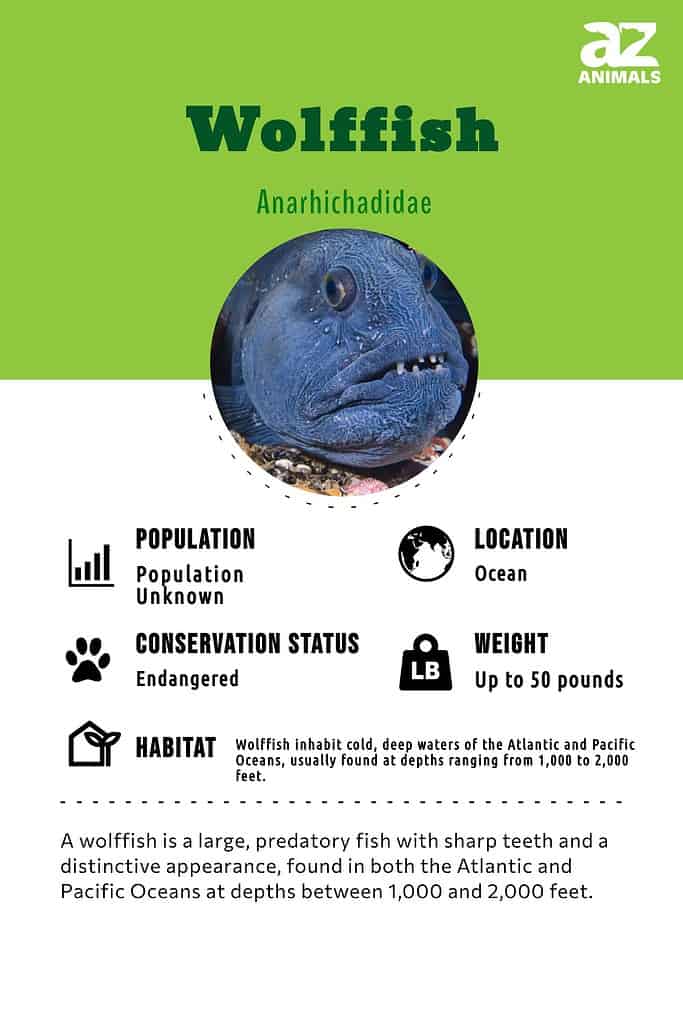
With its sharp canines, powerful jaws, and carnivorous lifestyle, the wolffish has a fearsome and devil-like appearance that lets you know it is a true predator of the sea.
The name derives from its resemblance to the famous canine wolf species, but the similarities end there. The wolffish is a rather solitary hunter that forms tight-knit bonds with its mate.
It is also an ambush predator and not a pack animal. The wolffish is an unfortunate victim of humanity’s destructive fishing practices, and several species are now in peril.
4 Incredible Wolffish Facts!
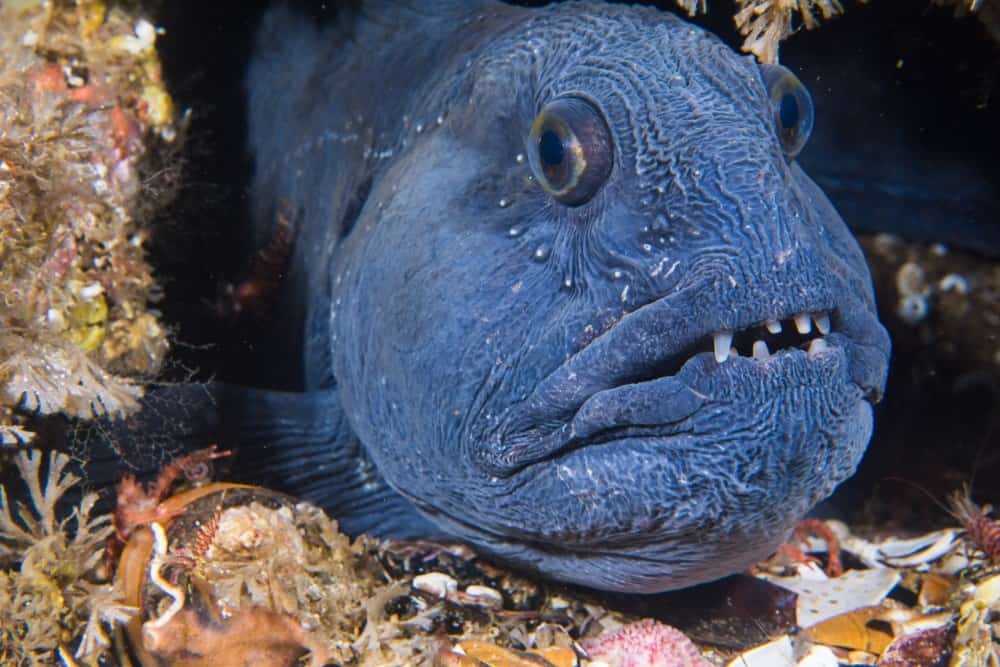
In certain regions, the wolf fish is referred to as the sea wolf, devil fish, or eel wolf.
©Joern_k/Shutterstock.com
- The wolf fish is also known as the sea wolf, devil fish, or eel wolf in some places.
- The wolf fish can thrive in the Arctic regions as far north as Greenland. It has evolved antifreeze proteins that circulate in the blood to keep its body functioning properly in the cold waters of the north.
- These fish has a very powerful bite force that can crush the hard shell of mollusks and crustaceans almost instantly. Curiously, it does not usually hunt or feed on the soft flesh of other fish.
- Lacking a bladder: This fish doesn’t have a swim bladder or a bladder full of air. As a result, they have to keep swimming at all times. If they stopped to float, they’re so heavy they would sink to the bottom!
Evolution and Origins
The Anarhichadidae family said to have begun roughly 50 million years ago, is where the evolution and origins of wolffish may be found. Natural selection and adaptation to their habitat, which includes dwelling at extreme depths and in freezing water temperatures, are likely to have led to these fish’s current shape.
The wolffish have evolved over time to have their distinctively pointed teeth, strong jaws, and other physical features that help them hunt and survive in their aquatic environments.
Furthermore, the Atlantic wolffish can live for up to twenty years and have a delayed reproductive cycle, as they are unable to reproduce until they reach eight to ten years of age.
During the spring to summer months, they pair up to breed, with mating occurring in the fall. Unlike most fish species, their method of fertilizing their eggs is quite distinct.
Different Types
Here are the different types of wolfish:
- Northern wolffish: Anarhichas denticulatus Krøyer, 1845.
- Atlantic wolffish (also known as sea wolf): Anarhichas lupus Linnaeus, 1758.
- Spotted wolffish: Anarhichas minor Olafsen, 1772.
- Bering wolffish: Anarhichas orientalis Pallas, 1814.
Scientific Name
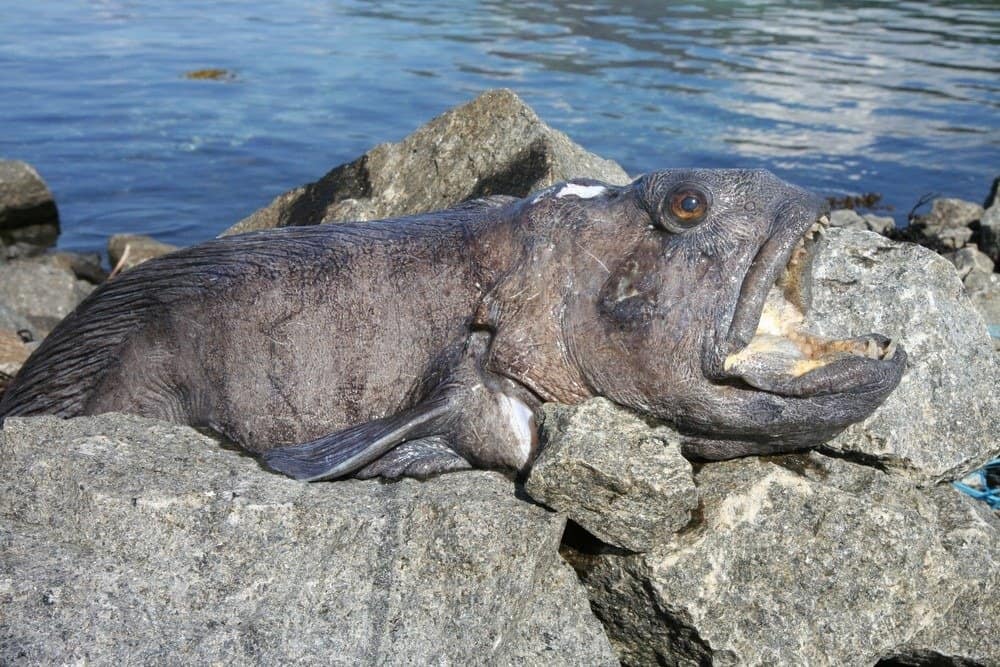
The Anarhichadidae family, commonly known as wolffish, received its name from a Greek word meaning “climb up.”
©Ufulum/Shutterstock.com
The wolffish is a family of species that goes by the scientific name of Anarhichadidae. This apparently derives from a Greek term meaning climb up.
They are most closely related to eelpouts, gunnels, and quillfish in the order of Perciformes. This is actually one of the most diverse orders of animals in the world. It comprises more than 10,000 species and 40% of all bony fish.
Species
There are currently five documented species of these fish divided among two genera. Four of these species reside in the genus Anarhichas, while the wolf eel is the only species in the genus of Anarrhichthys. Here is a list of all five Wolffish species.
The main difference between them is their appearance and location:
- Atlantic Wolffish: Featuring a blue-gray body, a large dorsal fin, and a light underside, this species resides in a stretch of territory between Labrador, Massachusetts, Greenland, Iceland, the North Sea area, and the coasts of Norway and Russia. It also resides as far south as France and Spain. The scientific name for this species is Anarhichas lupus (lupus means wolf in Latin).
- Spotted Wolffish: Also known as a leopard fish, this species inhabits both sides of the North Atlantic Ocean between Russia and Canada. Featuring dark spots, the color varies between olive green and brown.
- Northern Wolffish: Also known as the rock turbot, the bull-headed catfish, the Arctic wolffish, and many other names, this species is native to the North Atlantic and the Arctic Oceans.
- Bering Wolffish: As the name implies, this species is found around the Pacific regions of Russia and Alaska.
- Wolf Eel: This species has a very long body that resembles an eel, but it is actually a pure wolffish. It resides in the North Pacific region.
Appearance
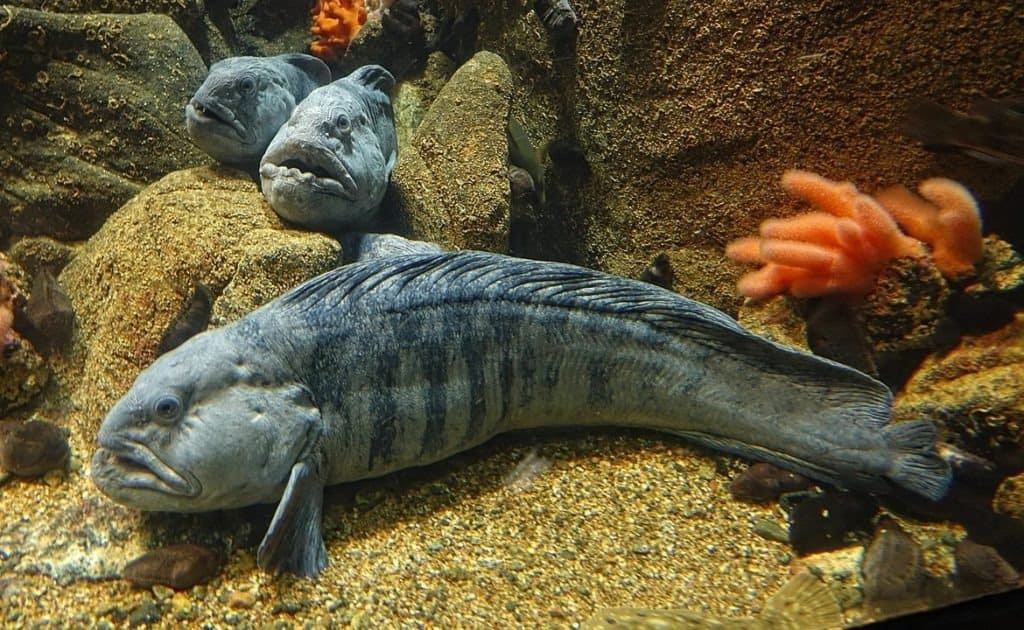
To the human eye, these fish may seem unattractive, rugged, and even devilish in appearance, but their looks can be misleading.
©Bjørn Christian Tørrissen, CC BY-SA 4.0, via Wikimedia Commons – License
These fish appears quite ugly, grizzled, and almost devil-like to the human eye but looks can be deceiving. There is nothing particularly aggressive about the wolffish compared to any other carnivore, whether appealing or not to our visual senses.
The wolffish is characterized by its incredibly long body (up to 7.5 feet), a big head, slender tail, powerful jaws that can inflict a painful wolffish bite, and multiple rows of teeth, some of which project outward from the mouth even when it’s closed.
The most common colors are blue, gray, brown, and olive green sometimes accompanied by stripes along the side of the body. It has very rudimentary and reduced scales almost hidden in the skin.
Most species have a long dorsal fin running the entire length of the back and another fin covering much of the stomach and pelvic areas. The wolffish moves through the water very slowly by waving its body back and forth like an eel.
Distribution, Population, and Habitat
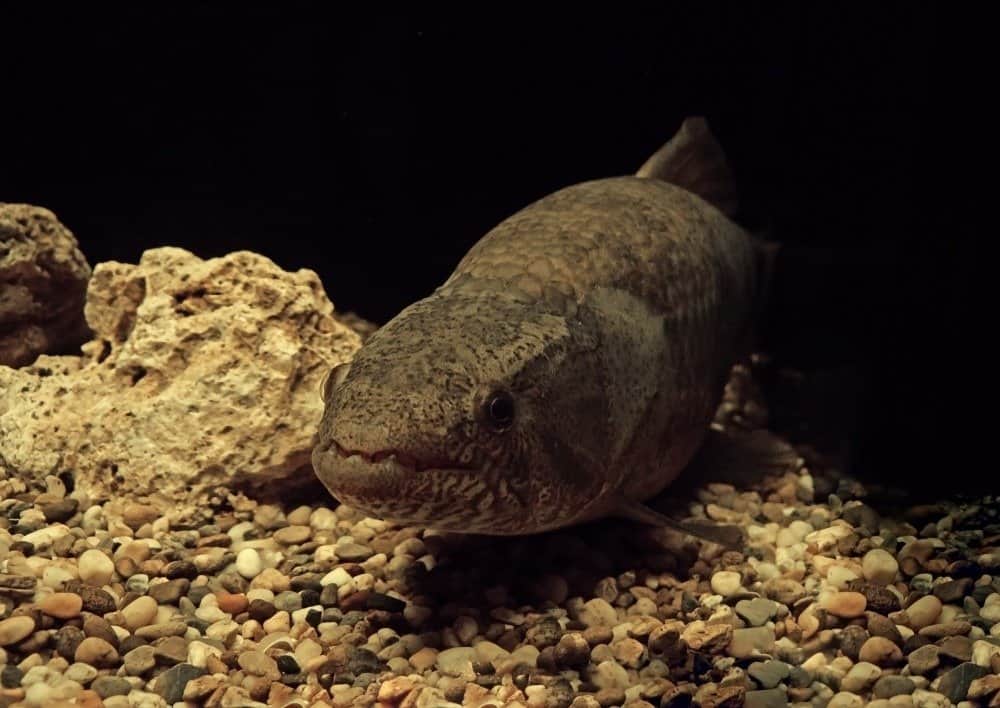
The wolffish can be found in both the Atlantic and Pacific Oceans, typically living at depths ranging from 1,000 to 2,000 feet.
©Cherdchai Chaivimol/Shutterstock.com
The wolffish resides in the Atlantic and Pacific Oceans at depths between 1,000 feet and 2,000 feet. For most of the day, the wolffish lie patiently in crevices or caves to surprise and ambush unsuspecting prey that happens to pass by. This sedentary lifestyle is a deliberate tactic to kill prey in the most efficient manner possible since the wolffish is not very fast.
Several species of wolffish have been threatened by humans. It is rarely consumed in large enough quantities for overfishing to be a problem, but in some parts of the Atlantic, population numbers have declined drastically as a result of habitat destruction and accidental catches.
Some trawling methods are so indiscriminate that they cause both problems at the same time. As the net is dragged across the bottom of the sea, it disrupts habitats and catches everything in its path, including huge masses of wolffish eggs, which may eradicate an entire generation of the species. One scientist estimated that trawling affected every inch of the New England seafloor between 1984 and 1990.
And even when it doesn’t affect the wolffish directly, trawling will catch other animals, thus reducing the abundance of prey on which the wolffish relies for survival. Without appropriate conservation and population management efforts, some wolffish are facing the real possibility of extinction.
Predators and Prey
The wolffish is an opportunistic bottom feeder that will wait for the prey to come to it. With its sharp canines, the wolffish bite aids it in eating sea creatures that are otherwise tough to consume.
The wolffish is well-adapted for crunching into the tough shells of crabs, clams, sea urchins, starfish, and other hard-shelled prey. It plays an important role in the ecosystem by keeping these fast-reproducing creatures in check.
Because of its size and the ferocity of the wolffish bite, the wolffish has relatively few regular predators besides sharks and humans. Even then it is hardly the first choice of prey, because the wolffish can inflict a very painful bite on humans or any other creature in defense of itself. Otherwise, though, it is not very aggressive.
Reproduction and Lifespan
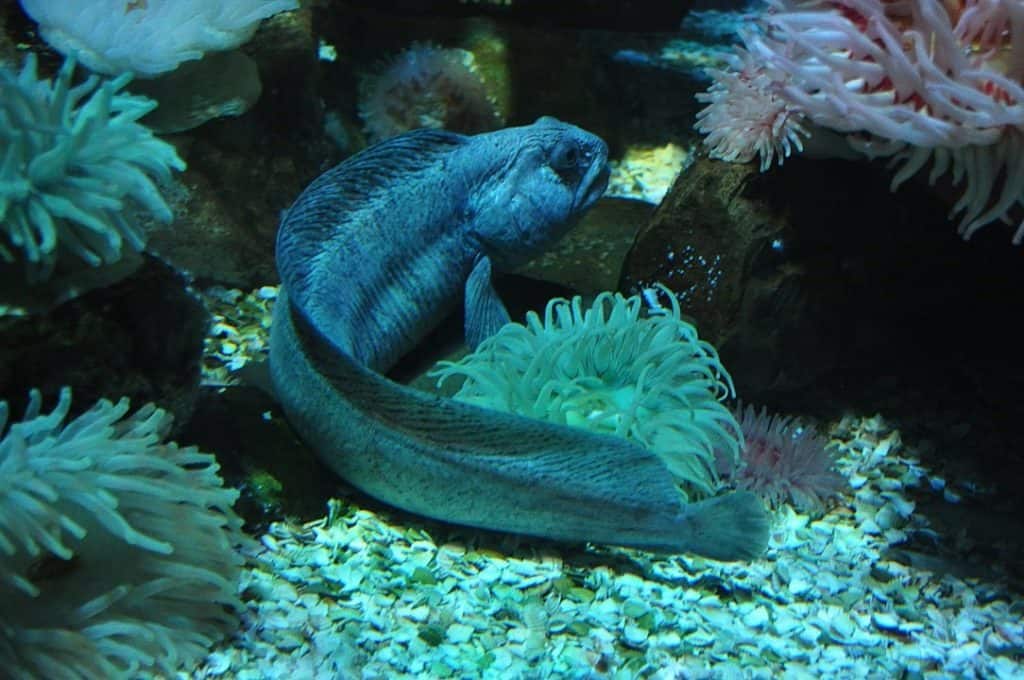
The wolffish has a unique reproductive cycle. During the spawning season, which typically occurs in September and October, they form paired relationships and may even mate for life.
©Nilfanion, CC BY-SA 4.0, via Wikimedia Commons – License
These fish has a rather unusual reproduction cycle. In the spawning season, which peaks around September and October, it forms bonded pairs and sometimes even mates for life. Unlike many species of fish, in which the females release unfertilized eggs into the water, the wolffish fertilizes the eggs internally. The female then lays thousands of eggs in huge masses between seaweed or crevices.
It takes around three to nine months for the eggs to fully hatch. Both parents play a pivotal role in raising the young, but the father has the main task of protecting the larvae in the nest for the next few months before they become independent.
The young fry reaches sexual maturity at a relatively late age of five or sometimes even more (this late maturity also means that it takes time for numbers to recover when they fall, complicating conservation efforts). The typical wolffish has a life expectancy of more than 12 years.
Fishing and Cooking
The Atlantic wolffish is a target of recreational fishermen due to its appealing taste.
The Atlantic wolffish, like the northern and spotted wolffish, is often caught in commercial fishermen’s nets as bycatch. This means the commercial fishermen don’t intend to catch them, but they end up in the nets with other fish in the environment.
The population and habitat of these fish are under threat from nets used for bottom trawling. These nets disrupt their eggs, the adults, and the elements of their habitat.
The Atlantic wolfish has a sweet flavor that some have compared to lobster. It’s usually baked, grilled, or broiled. They are low in calories, but high in fat and protein.
There are 10 to 15 tonnes of these caught each year. Also, there are approximately 1,000 tonnes of spotted wolfish are caught each year.
Some recipes for Atlantic wolffish include:
View all 108 animals that start with WWolffish FAQs (Frequently Asked Questions)
What kind of fish is a wolfish?
The wolffish belongs to the class of ray-finned fish known as the Actinopterygii. It is named for the shape of the dorsal fin and ventral fins along the body. Other common types of ray-finned fish include tuna, swordfish, salmon, and cod. However, the wolffish evolved so long ago that it more closely resembles other eel-like fish such as eelpouts and gunnels.
Can you eat wolffish?
Yes, the wolffish is perfectly edible for the human palate, and many places sell the meat. But perhaps because of how relatively uncommon it is, this cuisine is not as popular as many other types of fish.
What does wolffish taste like?
The white flesh of wolffish has a sweet, subtle flavor. Some people have described that it tastes like a lobster.
How do you cook wolffish?
The wolffish can be baked, broiled, fried, grilled, steamed, and sautéed with relative ease.
Where are wolffish found?
The wolffish is found along the coasts of the Atlantic and Pacific Oceans. It dwells on the seafloor to capture passing prey with its sharp and fearsome-looking teeth.
What is a wolffish?
A wolffish is a large fish that lives in the rocks and in rock crevices near the bottom of the ocean. They are carnivores that eat crabs, sea urchins, snails, and other sea creatures with shells. They have powerful jaws that bite into prey, crushing their shell and grinding it to pieces. They are giant fish measuring up to 5 feet in length and weighing 40 pounds.
What does a wolffish look like?
A wolffish has a large head with sharp teeth peaking out of its mouth. It has a slender body with a dorsal fin running the length of its back and a smaller version of that fin on its underside.
Are wolffish aggressive?
No. These fish like to stay hidden in rock crevices. If one does bite a human, it is usually because it feels threatened. For example, if a scuba diver sticks his or her hand beneath a rock, a wolffish hiding there may bite the diver’s hand. The fish thinks it’s being attacked and defends itself. This is normal behavior throughout the animal world.
Are Wolffish herbivores, carnivores, or omnivores?
Wolffish are Carnivores, meaning they eat other animals.
What Kingdom do Wolffish belong to?
Wolffish belong to the Kingdom Animalia.
What phylum do Wolffish belong to?
Wolffish belong to the phylum Chordata.
What class do Wolffish belong to?
Wolffish belong to the class Actinopterygii.
What family do Wolffish belong to?
Wolffish belong to the family Anarhichadidae.
What order do Wolffish belong to?
Wolffish belong to the order Perciformes.
What type of covering do Wolffish have?
Wolffish are covered in Scales.
What are some predators of Wolffish?
Predators of Wolffish include sharks and humans.
What is the scientific name for the Wolffish?
The scientific name for the Wolffish is Anarhichadidae.
What is the lifespan of a Wolffish?
Wolffish can live for at least 12 years.
How many species of Wolffish are there?
There are 5 species of Wolffish.
What is a distinguishing feature of the Wolffish?
Wolffish have a long eel-like body and sharp teeth.
What is the biggest threat to the Wolffish?
The biggest threats to Wolffish are habitat destruction and accidental catches.
How do Wolffish have babies?
Wolffish lay eggs.
What are the differences between a wolffish and a barracuda?
The key differences between a wolffish and a barracuda are size, color, habits, habitat, diet, lifespan, and physical features.
Thank you for reading! Have some feedback for us? Contact the AZ Animals editorial team.
Sources
- Britannica, Available here: https://www.britannica.com/animal/wolffish
- Conservation Law Foundation, Available here: chrome-extension://ohfgljdgelakfkefopgklcohadegdpjf/http://www.clf.org/wp-content/uploads/2013/03/Wolffish-fact-sheet.pdf

















